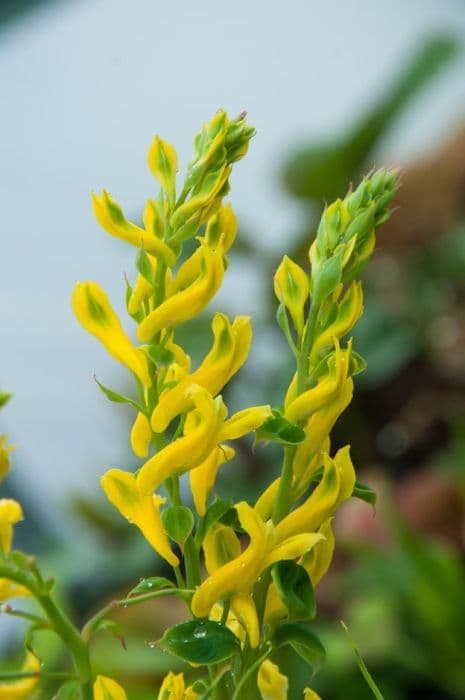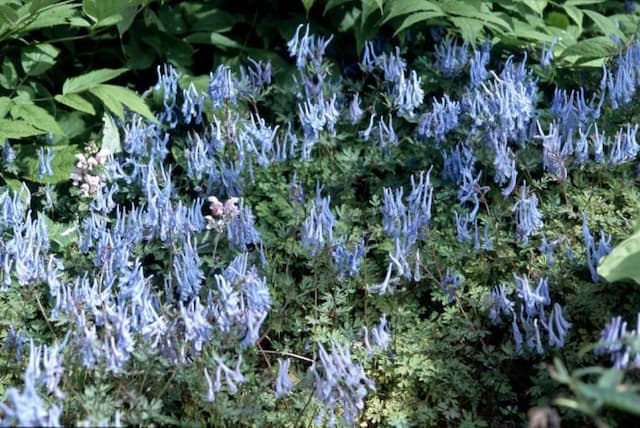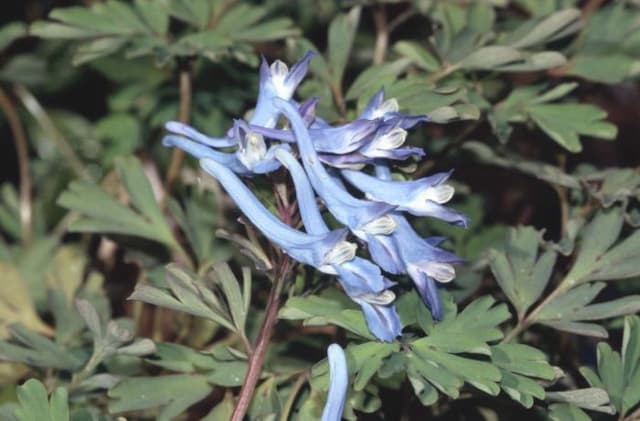Mexican Tulip Poppy Hunnemannia fumariifolia 'Sunlite'

ABOUT
The Hunnemannia fumariifolia 'Sunlite', commonly known as the Mexican Tulip Poppy or Golden Cup, is a striking flowering plant with visually appealing characteristics. It exhibits a bushy growth habit featuring fine, lace-like bluish-green foliage that looks delicate and fern-like. The stems are slender and upright, supporting the weight of the blooms with a graceful bearing. The most captivating aspect of the Mexican Tulip Poppy 'Sunlite' are its vibrant, cup-shaped flowers. Each bloom presents itself in a bright, clear, lemon-yellow hue that exudes a sunny and cheerful disposition. The petals are satiny and slightly crinkled, almost resembling crepe paper, which adds a touch of texture to the overall appearance. The flowers boast a large, open face with a subtle but attractive contrast created by the darker colored, prominent stamens at the center, enhancing its ornamental value. The blooms of the Mexican Tulip Poppy 'Sunlite' are carried individually atop the stems, making each flower stand out distinctly against the vegetation below. Despite lacking detail on its precise dimensions, it's evident that the plant's floral display is proportionate to its stature, providing a balanced and impactful visual interest in garden settings. Its appearance is further complemented by the continuous flowering habit that extends through the warmer seasons, offering a prolonged period of decorative appeal.
About this plant
 Names
NamesFamily
Papaveraceae
Synonyms
Mexican Tulip Poppy, Golden Cup
Common names
Hunnemannia fumariifolia, Eschscholzia fumariifolia.
 Toxicity
ToxicityTo humans
Mexican Tulip Poppy is not widely recognized as a toxic plant to humans. There is limited information available regarding its toxicity profile. Therefore, caution is advised since the full extent of its effects is not well documented. If you suspect poisoning from any plant, it is important to seek medical attention or contact a poison control center for advice.
To pets
Mexican Tulip Poppy is also not widely known to be toxic to pets. However, since many plants can have unexpected effects on animals, it is always prudent to monitor your pets and prevent them from ingesting plants. If you suspect your pet has ingested Mexican Tulip Poppy and is showing signs of illness, consult a veterinarian promptly.
 Characteristics
CharacteristicsLife cycle
Annuals
Foliage type
Deciduous
Color of leaves
Green
Flower color
Yellow
Height
2 feet (60 cm)
Spread
1 foot (30 cm)
Plant type
Herb
Hardiness zones
7
Native area
Mexico
Benefits
 General Benefits
General Benefits- Ornamental Appeal: The Hunnemannia fumariifolia 'Sunlite', commonly known as Mexican Tulip Poppy, has bright yellow flowers which add a splash of color to gardens and landscapes.
- Drought Resistance: Once established, this plant is known for its ability to tolerate dry conditions, making it suitable for xeriscaping or regions with low water availability.
- Pollinator Attraction: The vibrant flowers attract pollinators such as bees and butterflies, which are vital for the ecosystem and help in plant reproduction.
- Low Maintenance: Mexican Tulip Poppy requires minimal care once established, making it a convenient choice for both novice and experienced gardeners.
- Fast Growing: The plant tends to grow quickly, providing quick coverage and satisfaction for those looking to fill garden spaces efficiently.
- Sunlight Lover: It thrives in full sun, making it ideal for sunny spots where other plants might struggle.
- Heat Tolerance: This plant can withstand high temperatures, which is particularly beneficial in hot climates or during summer heat waves.
- Versatility: The Mexican Tulip Poppy can be used in various landscaping designs, including borders, rock gardens, and as a focal point in flower beds.
- Seasonal Interest: It blooms from mid-spring to early fall, providing long-lasting visual interest throughout the growing season.
- Soil Adaptability: While preferring well-drained soil, it can adapt to a wide range of soil types, decreasing the need for soil amendments.
 Medical Properties
Medical PropertiesThis plant is not used for medical purposes.
 Air-purifying Qualities
Air-purifying QualitiesThis plant is not specifically known for air purifying qualities.
 Other Uses
Other Uses- Hunnemannia fumariifolia 'Sunlite', commonly known as the Mexican Tulip Poppy or simply Tulip Poppy, can be used as a dye source; the bright yellow petals can provide a natural dye for fabrics and other crafts.
- Its sap can be used as a mild adhesive for small crafts or as a temporary botanical 'glue' when propagating plants.
- The Tulip Poppy's stems can be used in weaving small items like baskets, providing a natural and biodegradable option for crafters.
- Pressed Tulip Poppy flowers can be used in decorative art, such as in the creation of bookmarks, greeting cards, or in scrapbooking.
- Due to its bright and vivid color, the petals of the Tulip Poppy can be incorporated into natural confetti for eco-friendly celebrations.
- The plant can provide a vibrant yellow watercolor paint when the petals are crushed and mixed with a water-based solution.
- Landscape design - These flowers can be used in xeriscaping, which is an environmentally friendly form of landscaping that reduces the need for irrigation.
- Photography prop – The attractive blooms can serve as a natural prop for photo shoots, providing a burst of color and organic feel to images.
- Educational tool – The Tulip Poppy can be used to teach children about plant biology, pollination, and the lifecycle of plants in school gardens.
- Culinary garnish – Although not a common use, the petals may be used as a decorative edible garnish, provided they haven’t been treated with pesticides and are safe for consumption.
Interesting Facts
 Feng Shui
Feng ShuiThe Mexican Tulip Poppy is not used in Feng Shui practice.
 Zodiac Sign Compitability
Zodiac Sign CompitabilityThe Mexican Tulip Poppy is not used in astrology practice.
 Plant Symbolism
Plant Symbolism- Vitality: The bright yellow flowers of Mexican Tulip Poppy symbolize energetic vitality and the joy of life.
- Warmth: Its warm, sun-like color conveys feelings of happiness and warmth, similar to the nourishing rays of the sun.
- Adaptability: A sun-loving plant that adjusts to varying conditions, it represents the ability to thrive in different environments and situations.
- Resilience: Mexican Tulip Poppy's capacity to regenerate after being disturbed symbolizes resilience and the strength to recover from challenges.
 Water
WaterFor the Mexican Tulip Poppy, which is the common name for Hunnemannia fumariifolia 'Sunlite', it is crucial to maintain a balance in watering. The soil should be kept moist but not waterlogged. During the growing season, water the plant thoroughly once a week with approximately 1 to 2 gallons, depending on the size of the plant and the weather conditions. During hotter periods, increase to twice a week to ensure adequate moisture. In winter or cooler seasons, reduce watering but do not let the soil completely dry out.
 Light
LightThe Mexican Tulip Poppy thrives best in full sunlight. It ideally needs at least 6 to 8 hours of direct sunlight daily. Place it in a location where it can receive unobstructed sunlight for the majority of the day to ensure optimal growth and blooming.
 Temperature
TemperatureThe Mexican Tulip Poppy prefers moderate temperatures and should not be exposed to extremes. The ideal temperature range is between 50 and 75 degrees Fahrenheit. It can survive minimum temperatures down to around 30 degrees Fahrenheit but should be protected from frost. During the summer, make sure it's not in a location where the temperature exceeds 90 degrees Fahrenheit regularly.
 Pruning
PruningPruning of the Mexican Tulip Poppy is essential for maintaining plant health and encouraging blooming. Deadheading, or removing spent flowers, should be done regularly to promote continuous blooming. Cut back the foliage in late fall or early winter after the plant has finished blooming. Pruning during the growing season is generally not needed unless you are shaping the plant or removing damaged stems.
 Cleaning
CleaningAs needed
 Soil
SoilMexican Tulip Poppy thrives in a well-draining, sandy soil mix, slightly acidic to neutral in pH, ideally between 6.0 and 7.0. An equal mix of potting soil, coarse sand, and perlite or pumice can provide the optimal growing conditions.
 Repotting
RepottingMexican Tulip Poppy should be repotted every 2 to 3 years or when the plant outgrows its current pot. It's best to repot in spring as the plant enters a period of active growth.
 Humidity & Misting
Humidity & MistingMexican Tulip Poppy prefers moderate humidity levels but is quite tolerant of drier conditions. It does not require high humidity and can thrive in typical indoor humidity levels found in most homes.
 Suitable locations
Suitable locationsIndoor
Ensure full sun exposure and good air circulation for the Mexican Tulip Poppy indoors.
Outdoor
Plant in full sun and well-draining soil for the Mexican Tulip Poppy outdoors.
Hardiness zone
8-11 USDA
 Life cycle
Life cycleThe life of the Mexican Tulip Poppy 'Sunlite' (Hunnemannia fumariifolia 'Sunlite') begins with seed germination, which is typically prompted by warm temperatures and moist soil conditions. Following germination, seedlings emerge and grow into young plants, developing a root system and foliage through vegetative growth. As the plant matures, it develops distinctive yellow, tulip-like flowers, which attract pollinators and mark the reproductive stage. After pollination, the flowers develop into capsules containing numerous seeds. As the capsules ripen and dry, they eventually open to release the seeds into the environment. Finally, the plant completes its life cycle and dies back, usually after it has set seed, although in some climates the plant may behave as a perennial, surviving through multiple growing seasons.
 Propogation
PropogationPropogation time
Spring-Summer
The plant commonly known as the Mexican Tulip Poppy (Hunnemannia fumariifolia 'Sunlite') is typically propagated by seeds. The best time for sowing the seeds is in spring after the last frost when the soil has warmed up. To propagate, scatter the seeds lightly on the surface of well-draining soil and gently press them in, taking care not to bury them deeply since they require light to germinate. Keep the soil moist but not soggy, and in a spot that receives plenty of sunlight. Sprouting usually occurs within two to three weeks; afterwards, thin the seedlings to allow for ample growing space. Seed propagation is the most popular because it is straightforward and usually results in healthy, blooming plants within a single growing season.









